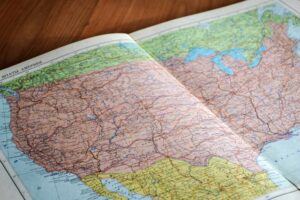
While we’re taught that Christopher Columbus discovered America in 1492, the actual tale of who first explored North America is much more convoluted.
The issue of who discovered America is a tough one to answer. While many school children are taught that Christopher Columbus was responsible for the discovery of America in 1492, the true story of how the land was discovered goes
But did Christopher Columbus discover America before other Europeans?
Recent studies, however, have shown that this isn’t the case. Most notably, a group of Icelandic Norse explorers led by Leif Erikson likely beat Columbus to the punch by approximately 500 years.
Who discovered America?
The answer is unclear. It all depends on what you mean by “discover.”
There are two ways to look at this question:
- First is related to the actual process of discovery
- Second deals with who first set foot on American soil
Christopher Columbus was not the first European explorer to discover America. That honor goes to the Vikings, who stumbled across North America more than five hundred years before Christopher Columbus did.
But Columbus was smart enough to get funding from other European countries because his investors were worried he would fall off the edge of the Earth if he didn’t have any land in sight.
The Viking sailors probably just kept going until they landed on a shore that wasn’t just more ocean.
The Vikings did explore and settle North America but were eventually forced out by Native Americans and the harsh weather conditions.
Columbus was able to return home safely after his initial trip and brought with him a newfound knowledge of the lands to the west of Europe.
This spurred countless explorers to try their own hands at sailing west to reach Asia, just as Columbus had done.
Leif Erikson: The Viking Who Found America
Leif Erikson was a Norse explorer and the first European thought to have landed in North America.
His father, Erik the Red, had been banished from Iceland around 982 CE and sailed west to an area he named Greenland.
Erik then sent out his son Leif to explore the region. Tradition holds that Leif landed in North America around the year 1000 and named the new lands Vinland.
Despite this, Christopher Columbus’ journeys led to a permanent European presence in the New World and initiated large-scale colonization.
Christopher Columbus and his journey to America
A common name for Christopher Columbus is the “Columbus of the Ocean Sea.”
This was because his expedition was the first to find a viable sailing route from Europe westward across the Atlantic Ocean to America and Asia, which made them available for trade.
Columbus had always wanted to sail west and after many failed attempts finally found some investors who agreed with his idea and would part with their money long enough for him to make it back from what he was certain would be a lucrative trip.
Columbus wasn’t looking for an unknown land, he thought he had landed in India when he first saw the American shores, but his investors were not keen to go around calling everything they found “India.”
So Columbus called the native people “Indians” because he believed that this land must be the eastern shores of Asia.
Columbus’ journey to America immediately spurred a race among competing European maritime powers (Spain and Portugal, primarily) to explore and colonize the “New World.”
The result was an explosion of European exploration, military conquest, and ultimately colonization across North and South America.
What did Columbus call America?
When Christopher Columbus first stumbled upon the Americas, he believed that he had landed on islands off the coast of Asia.
For this reason, he originally called the native people “Indians.”
The name America is derived from Americus Vespucius, an Italian explorer who was friends with Christopher Columbus. He named it after himself but people started calling it America instead.
For two centuries, Spain refused to acknowledge the name America, claiming that Columbus deserved all the credit, and after Ringmann’s death in 1513, Waldseemüller’s later maps did not include it, he referred to it as “Terra Incognita” with a note about Columbus’ discovery of the territory.
What island did Columbus land on?
In 1492, Columbus landed on what is now the Bahamas.
Columbus and his ships came to an island inhabited by the Lucayan people, who called it Guanahani. San Salvador was renamed in his honor.
What happened to the Native Americans?
After Columbus and his men arrived, they quickly set about enslaving and killing the native people. They forced them to work as their servants and give them gold that they found.
When Christopher Columbus came to America he brought with him diseases that were not common in America such as smallpox. These brought many people to their deaths.
Many Native Americans also died from famine after Europeans came and started to farm the land that was once theirs. The new food led them to get diabetes which killed many of them, too.
- Read also: The History Of Money and Its Evolution
- Read also: The History Of Pandemics
What happened after Columbus?
The European discovery of America was one of the most important events in world history since it marked the beginning of the transatlantic slave trade, also known as the “Black Atlantic.”
The Europeans enslaved millions of Africans for this purpose and brought them to America. They forced them to work on plantations together with native Americans which created an entirely new culture.
Christopher Columbus’ journeys led to a permanent European presence in the New World and initiated the large-scale European colonization of the Americas.
Summery
Leif Erikson is the first European to see and live in America for a whole Summer.
Columbus is the first European explorer/traveler to land on an island near what would be known as America.
He was not the first person born in Europe to reach American shores though, so he’s not technically “the” discoverer of America.
Columbus called the native people “Indians” because he believed that this land must be on the eastern shores of Asia.
Columbus’ journey to America immediately spurred a race among competing European maritime powers (Spain and Portugal, primarily) to explore and colonize the New World.
For two centuries, Spain refused to acknowledge the name America, claiming that Columbus deserved all the credit.
After Ringmann’s death in 1513, Waldseemüller’s later maps did not include it; he referred to it as “Terra Incognita” with a note about Columbus’ discovery of the territory.



